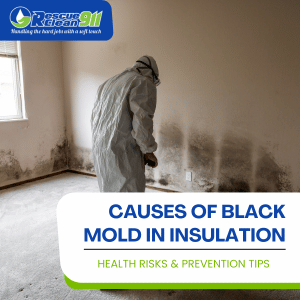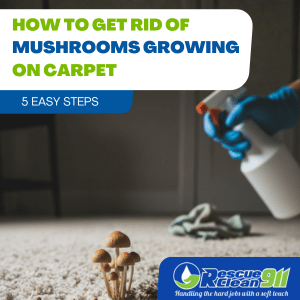Noticing a musty smell in house can be frustrating and concerning. That lingering damp scent isn’t just unpleasant—it can affect your indoor air quality and even contribute to respiratory issues or allergies.
Understanding why this odor develops and how to properly address it is essential for creating a healthy, fresh home environment.
Fortunately, with the right strategies, you can identify the source of the smell, eliminate it, and prevent it from returning.
What Causes a Musty Smell in House?
A musty smell typically develops due to excess moisture and poor ventilation, creating the perfect conditions for mold or mildew growth.
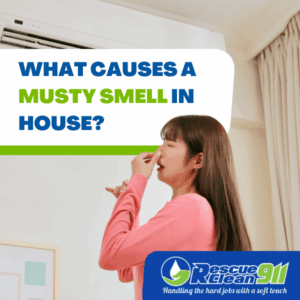 When airflow is limited, stale air becomes trapped, moisture lingers, and microbial volatile organic compounds (VOCs) are released, contributing to the familiar damp scent.
When airflow is limited, stale air becomes trapped, moisture lingers, and microbial volatile organic compounds (VOCs) are released, contributing to the familiar damp scent.
Key contributors include:
High humidity: Levels above 60% create ideal conditions for mold growth.
Damp conditions: Water damage, roof leaks, condensation, and wet clothing left in living spaces.
Poor ventilation: Lack of ceiling fans, open windows, or air circulation allows stagnant air to accumulate.
Porous materials: Carpets, upholstery, and fabrics easily absorb moisture and odor-causing bacteria.
Even homes without visible mold can experience a musty smell, because hidden mold in crawl spaces, walls, or air ducts often goes unnoticed until the odor becomes noticeable.
Signs That Mold or Mildew May Be Present
While some musty odors are minor, persistent smells may indicate mold and mildew growth, which can affect health. Be alert to:
Discoloration or staining on walls, ceilings, or floors
Damp clothing or fabrics that retain moisture
Wet spots around windows or front-loading washing machines
Dust accumulation combined with stale air
Skin rash or mild respiratory issues in residents
Remember, mold spores are invisible and can cause asthma attacks or respiratory irritation, so early detection is crucial.
Common Sources of Musty Odors
Mold can start growing in the span of a day, and any surfaces around your home that are damp can be a breeding ground for mold and a musty odor. The following are some places you may want to look if you notice a musty smell:
1. Carpets and Upholstery
Carpets are highly porous and can trap moisture from spills or water damage. Similarly, deep clean upholstered furniture is necessary because fabrics absorb odors over time. Mold and mildew growth can hide in the padding, producing lingering musty smells.
2. Mattresses and Bedding
Mattresses absorb moisture from both humidity and daily use. Spills or leaks worsen the problem. Regular washing and occasional deep cleaning help neutralize musty odors.
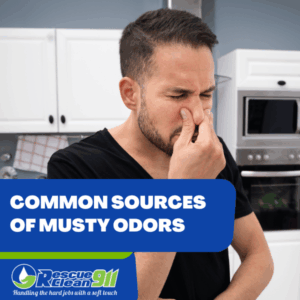 3. Clothing and Laundry
3. Clothing and Laundry
Damp clothing left in front-loading washing machines or laundry baskets contributes to microbial volatile organic compounds and odor-causing bacteria. Promptly drying clothes and reducing humidity prevents the problem.
4. Kitchens and Sponges
Dish sponges, with their constant moisture and food residue, are a hotspot for mold growth. Replacing or sanitizing sponges regularly is essential to reduce stale air and musty odors.
5. Hidden Mold and Crawl Spaces
Crawl spaces and behind walls may harbor hidden mold or mildew. These areas often have poor ventilation, causing moisture levels to rise, and a musty smell originates from these hidden zones.
How Poor Ventilation Contributes to Musty Smells
Poor ventilation traps stale air and moisture, creating damp conditions for mildew growth. Homes without ceiling fans, open windows, or proper air conditioning circulation are especially vulnerable.
Improving ventilation can include:
Opening windows when weather permits
Using ceiling fans to circulate air
Installing or cleaning air filters in heating and cooling systems
Running air purifiers with activated carbon filters to eliminate musty smells
Proper airflow prevents moisture from lingering, reducing volatile organic compounds that contribute to musty odors.
Tools Needed to Remove Musty Smells
Getting rid of a musty odor in your home is possible, but it does require the right tools.
It is essential to remember that when working with mold, the spores can be hazardous; therefore, it is best to take precautions and consult an expert for more significant mold problems.
Spores can also spread to other rooms, so always be careful when handling moldy items. Some of the most common tools to control mold include:
Gloves
You will need a pair of heavy-duty gloves for handling any molded items and scrubbing contaminated surfaces. You can purchase standard rubber gloves at your local hardware store or supermarket. You will generally want to throw out the gloves after use.
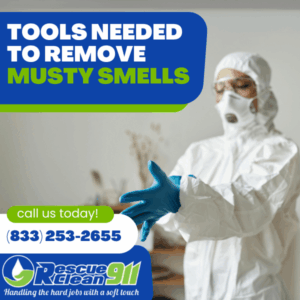 Trash bag
Trash bag
All contaminated items that you will be throwing out need to go into a plastic trash bag that can be sealed. This prevents mold spores from being dislodged from their host and floating away as you carry contaminated items from your house. Double-bagging in two plastic bags can also be a good idea.
Bleach
Bleach is an effective way to kill mold spores and is both easily and cheaply available. Dilute one cup of bleach in two parts of water for a mold cleaning solution. You can spray the bleach onto a surface and let it sit for 10 minutes to dissolve mold. Then wipe it away or scrub it to remove lingering spores.
Others
Depending on the source of the musty odor, you may need a few other tools to effectively control the smell. A washer with hot water capabilities can kill mold on clothing and linens.
A scrub brush may be necessary to loosen mold that has eaten away at hard surfaces. Natural cleaners like baking soda or vinegar can also be helpful for removing mold from surfaces.
DIY Steps to Eliminate Musty Odors
Getting rid of a house smell musty requires addressing both the source of moisture and the odor itself. Here’s a practical step-by-step guide:
1. Identify the Root Cause
Check for:
Roof leaks, water damage, or condensation
Damp carpets, walls, or porous materials
Stagnant air in crawl spaces or air ducts
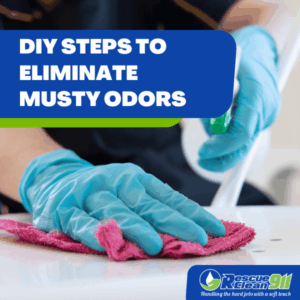 2. Reduce Humidity Levels
2. Reduce Humidity Levels
Maintain humidity levels below 60% using:
Dehumidifiers
Proper air conditioning
Improving ventilation and opening windows
3. Clean Fabrics and Surfaces
Deep clean upholstered furniture and carpets
Wash bedding and curtains in hot water
Use baking soda or lemon peels as natural deodorizers
4. Treat Mold and Mildew
Remove mold using bleach solutions or vinegar for smaller areas
For extensive mold and mildew growth, call for professional help
Regularly clean front-loading washing machines to prevent mold growth
5. Fresh Air and Air Purifiers
Open windows for fresh air circulation
Run an air purifier with activated carbon filters to neutralize musty odors
Ceiling fans and portable units improve a home’s air quality
6. Keep Your Home As Dry as Possible
Keep your home as dry as possible to prevent musty smells from returning.
Use dehumidifiers in areas with high humidity.
Avoid leaving wet items lying around.
Address any sources of moisture promptly.
How Long Does It Take To Remove The Smells?
Musty or moldy items need to be addressed to prevent additional mold growth. But the time it takes to get rid of a musty odor in your home depends on a number of factors.
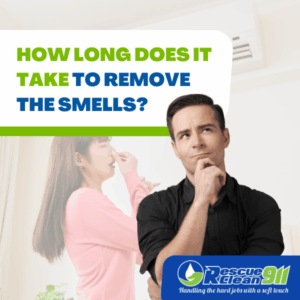 How extensive the mold growth was.
How extensive the mold growth was.If mold spreads to other areas in the home.
If odor-causing spores are trapped in nearby carpets and walls.
Air circulation in the affected space.
Whether or not odor neutralizers were used.
In many cases, a musty smell will begin to dissipate as soon as the source is removed. If this is something as simple as a sponge, the issue could be fixed relatively quickly.
But if there are multiple things causing a musty smell around your home, or the source of your smell is something more permanent, such as carpets or water damage on walls, the necessary work to remove a musty smell will also be more advanced.
In these cases, relying on a mold remediation company in South Florida is often the fastest and safest way to stop musty odors in your home.
They can quickly identify the cause, safely remove it, and clean the remaining area to remediate any lasting mold spores that might continue to cause an unpleasant odor.
Preventing Musty Smells in the Future
Prevention is the first line of defense against musty smells in the house. Key strategies include:
Regular cleaning: Deep clean carpets, upholstery, and surfaces to rid of musty smells
Moisture control: Address leaks, roof leaks, and condensation immediately
Ventilation: Keep windows open when possible and improve air circulation
Humidity management: Use dehumidifiers, air conditioning, and reduce high humidity
Natural deodorizers: Baking soda, lemon peels, or essential oils can absorb odors
Professional inspections: Periodically check crawl spaces, air ducts, and hidden areas for hidden mold
Excessive use of humidifiers can create damp conditions that may encourage mold growth if not properly monitored.
 Additional Tips for a Healthy Home
Additional Tips for a Healthy Home
Deep clean upholstered furniture and carpets every few months
Keep damp clothing and towels off the floor
Avoid stagnant air by using ceiling fans and opening windows
Address water damage and roof leaks promptly
Consider scented candles or essential oils as a temporary solution, but they don’t replace moisture control
Ensure the heating and cooling system is regularly serviced and the air filters are replaced
By combining these practices, you improve indoor air quality, prevent mold and mildew, and maintain a healthy home.
When to Call Professional Help
Sometimes DIY solutions aren’t enough. Call a trusted remediation company if:
Mold covers a large area or returns quickly
You suspect hidden mold in walls or crawl spaces
Musty odors persist despite cleaning and ventilation efforts
You or family members experience respiratory issues or asthma attacks
Professionals can identify the root cause, remove mold, and deep clean affected areas to ensure the home’s air is safe and fresh.
Enjoy a Fresh, Healthy Home
A musty smell in the house doesn’t just affect comfort; it impacts air quality and overall health. By identifying moisture sources, improving ventilation, cleaning fabrics and surfaces, and using air purifiers, you can eliminate musty smells and prevent them from returning.
For persistent or widespread mold issues, the experts at Rescue Clean 911 provide the professional solutions needed to restore a safe, fresh, and healthy living space.
For a more thorough cleaning to remove the musty smell in house, call us today!

